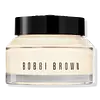Bobbi Brown Vitamin Enriched Face Base Moisturizer & Primer with Vitamin C + Hyaluronic Acid Versus Bobbi Brown Hydrating Face Cream Moisturizer
What's inside
What's inside
 Key Ingredients
Key Ingredients

 Benefits
Benefits

 Concerns
Concerns

 Ingredients Side-by-side
Ingredients Side-by-side

Water
Skin ConditioningCyclopentasiloxane
EmollientBis-Diglyceryl Polyacyladipate-2
EmollientButylene Glycol
HumectantPPG-2 Myristyl Ether Propionate
EmollientCetyl Alcohol
EmollientPEG-40 Stearate
EmulsifyingButyrospermum Parkii Butter
Skin ConditioningSqualane
EmollientGlyceryl Stearate
EmollientSorbitan Stearate
EmulsifyingEpilobium Angustifolium Extract
Skin ConditioningYeast Extract
Skin ConditioningBeta-Carotene
Skin ConditioningSodium Hyaluronate
HumectantCitrus Grandis Peel Oil
MaskingTocopheryl Acetate
AntioxidantMethyl Glucose Sesquistearate
EmollientPelargonium Graveolens Flower Oil
MaskingDimethicone Crosspolymer
Emulsion StabilisingAcrylates/C10-30 Alkyl Acrylate Crosspolymer
Emulsion StabilisingCarbomer
Emulsion StabilisingPEG-20 Methyl Glucose Sesquistearate
EmulsifyingC12-15 Alkyl Ethylhexanoate
EmollientTetrasodium EDTA
Sodium Hydroxide
BufferingPanthenol
Skin ConditioningMagnesium Ascorbyl Phosphate
AntioxidantLimonene
PerfumingCitronellol
PerfumingGeraniol
PerfumingLinalool
PerfumingChlorphenesin
AntimicrobialPhenoxyethanol
PreservativeWater, Cyclopentasiloxane, Bis-Diglyceryl Polyacyladipate-2, Butylene Glycol, PPG-2 Myristyl Ether Propionate, Cetyl Alcohol, PEG-40 Stearate, Butyrospermum Parkii Butter, Squalane, Glyceryl Stearate, Sorbitan Stearate, Epilobium Angustifolium Extract, Yeast Extract, Beta-Carotene, Sodium Hyaluronate, Citrus Grandis Peel Oil, Tocopheryl Acetate, Methyl Glucose Sesquistearate, Pelargonium Graveolens Flower Oil, Dimethicone Crosspolymer, Acrylates/C10-30 Alkyl Acrylate Crosspolymer, Carbomer, PEG-20 Methyl Glucose Sesquistearate, C12-15 Alkyl Ethylhexanoate, Tetrasodium EDTA, Sodium Hydroxide, Panthenol, Magnesium Ascorbyl Phosphate, Limonene, Citronellol, Geraniol, Linalool, Chlorphenesin, Phenoxyethanol
Trehalose
HumectantDimethicone
EmollientButylene Glycol
HumectantCetyl Alcohol
EmollientEthylhexyl Palmitate
EmollientCaprylic/Capric/Myristic/Stearic Triglyceride
EmollientAleurites Moluccanus Seed Oil
Skin ConditioningMyristyl Myristate
EmollientGlyceryl Stearate
EmollientAlgae Extract
EmollientCetyl Phosphate
EmulsifyingPolyperfluoromethylisopropyl Ether
Skin ConditioningCoriandrum Sativum Seed Oil
EmollientRosmarinus Officinalis Leaf
Skin ConditioningRosa Canina Fruit Oil
EmollientElettaria Cardamomum Seed Oil
MaskingLavandula Angustifolia Extract
Skin ConditioningJasminum Officinale Oil
MaskingTocopheryl Acetate
AntioxidantCholesterol
EmollientLinoleic Acid
CleansingGlycerin
HumectantCaffeine
Skin ConditioningPEG-10 Dimethicone
Skin ConditioningMyristyl Laurate
Phytantriol
HumectantAcrylates Copolymer
Lecithin
EmollientSodium Acrylate/Acrylonitrogens Copolymer
Skin ConditioningPhytosphingosine
Skin ConditioningPropylene Glycol Stearate
Skin ConditioningSodium Hyaluronate
HumectantPolysorbate 20
EmulsifyingCaprylyl Glycol
EmollientSorbitan Laurate
EmulsifyingMyristyl Alcohol
EmollientPropylene Glycol Laurate
Skin ConditioningTocopherol
AntioxidantGlycine
BufferingSodium Hydroxide
BufferingCarbomer
Emulsion StabilisingHydroxyproline
Skin ConditioningProline
Skin ConditioningCitric Acid
BufferingHexylene Glycol
EmulsifyingDisodium EDTA
Trehalose, Dimethicone, Butylene Glycol, Cetyl Alcohol, Ethylhexyl Palmitate, Caprylic/Capric/Myristic/Stearic Triglyceride, Aleurites Moluccanus Seed Oil, Myristyl Myristate, Glyceryl Stearate, Algae Extract, Cetyl Phosphate, Polyperfluoromethylisopropyl Ether, Coriandrum Sativum Seed Oil, Rosmarinus Officinalis Leaf, Rosa Canina Fruit Oil, Elettaria Cardamomum Seed Oil, Lavandula Angustifolia Extract, Jasminum Officinale Oil, Tocopheryl Acetate, Cholesterol, Linoleic Acid, Glycerin, Caffeine, PEG-10 Dimethicone, Myristyl Laurate, Phytantriol, Acrylates Copolymer, Lecithin, Sodium Acrylate/Acrylonitrogens Copolymer, Phytosphingosine, Propylene Glycol Stearate, Sodium Hyaluronate, Polysorbate 20, Caprylyl Glycol, Sorbitan Laurate, Myristyl Alcohol, Propylene Glycol Laurate, Tocopherol, Glycine, Sodium Hydroxide, Carbomer, Hydroxyproline, Proline, Citric Acid, Hexylene Glycol, Disodium EDTA
Ingredients Explained
These ingredients are found in both products.
Ingredients higher up in an ingredient list are typically present in a larger amount.
Butylene Glycol (or BG) is used within cosmetic products for a few different reasons:
Overall, Butylene Glycol is a safe and well-rounded ingredient that works well with other ingredients.
Though this ingredient works well with most skin types, some people with sensitive skin may experience a reaction such as allergic rashes, closed comedones, or itchiness.
Learn more about Butylene GlycolCarbomer is a polymer of acrylic acid. Its main role is to create a gel consistency.
A high amount of carbomer can cause pilling or balling up of products. Don't worry, most products contain 1% or less of carbomer.
Cetyl Alcohol is a fatty alcohol. Fatty Alcohols are most often used as an emollient or to thicken a product.
Its main roles are:
Though it has "alcohol" in the name, it is not related to denatured alcohol or ethyl alcohol.
The FDA allows products labeled "alcohol-free" to have fatty alcohols.
Learn more about Cetyl AlcoholGlyceryl Stearate is a mix of glycerin and stearic acid.
It is used to stabilize the mixing of water and oil ingredients. By preventing these ingredients from separating, it can help elongate shelf life. It can also help thicken the product's texture.
As an emollient, it helps soften skin and supports barrier-replenishing ingredients.
In cosmetics, Glyceryl Stearate is often made from vegetable oils or synthetically produced.
This ingredient may not be fungal-acne safe
Fun fact: The human body also creates Glyceryl Stearate naturally.
Learn more about Glyceryl StearateSodium Hyaluronate is hyaluronic acid's salt form. It is commonly derived from the sodium salt of hyaluronic acid.
Like hyaluronic acid, it is great at holding water and acts as a humectant. This makes it a great skin hydrating ingredient.
Sodium Hyaluronate is naturally occurring in our bodies and is mostly found in eye fluid and joints.
These are some other common types of Hyaluronic Acid:
Learn more about Sodium HyaluronateSodium Hydroxide is also known as lye or caustic soda. It is used to adjust the pH of products; many ingredients require a specific pH to be effective.
In small amounts, sodium hydroxide is considered safe to use. However, large amounts may cause chemical burns due to its high alkaline.
Your skin has a natural pH and acid mantle. This acid mantle helps prevent harmful bacteria from breaking through. The acid mantle also helps keep your skin hydrated.
"Alkaline" refers to a high pH level. A low pH level would be considered acidic.
Learn more about Sodium HydroxideTocopheryl Acetate is AKA Vitamin E. It is an antioxidant and protects your skin from free radicals. Free radicals damage the skin by breaking down collagen.
One study found using Tocopheryl Acetate with Vitamin C decreased the number of sunburned cells.
Tocopheryl Acetate is commonly found in both skincare and dietary supplements.
Learn more about Tocopheryl Acetate